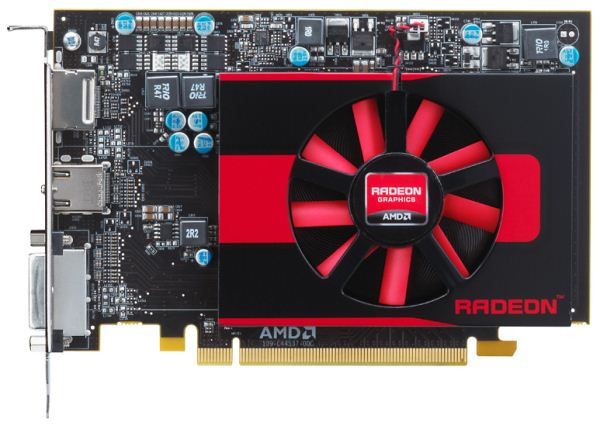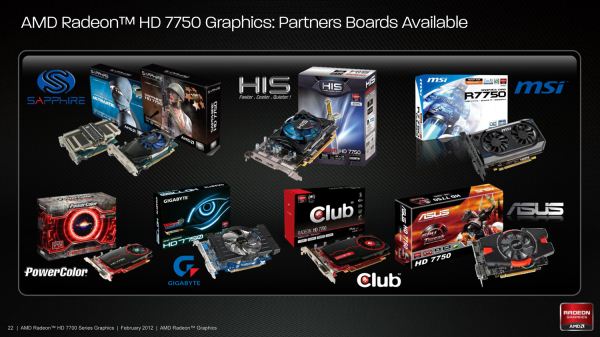AMD Radeon HD 7750 & Radeon HD 7770 GHz Edition Review: Evading The Price/Performance Curve
by Ryan Smith & Ganesh T S on February 15, 2012 12:01 AM EST- Posted in
- GPUs
- AMD
- HTPC
- GCN
- Radeon HD 7000
Meet the Radeon HD 7750
We’ll kick things off as always with a look at the cards themselves, starting with the Radeon HD 7750. As we alluded to before, this is the de-facto replacement for the Radeon HD 6670, and you only have to take one look at the card to understand why.
AMD’s reference design for the 7750 is virtually identical to the full-profile 6670 or the FirePro V4900, which should come as no surprise given that all of these cards are or were AMD’s top sub-75W cards in their respective markets. As a result, like those cards the reference 7750 is a full-profile card featuring a single-wide active cooler.
As the 7750 is AMD’s cheapest Southern Islands card, you won’t find much else on the card to speak of. As a sub-75W card it doesn’t need external power, and cementing its position as the replacement for the 6670 there isn’t a CrossFire connector on the card. For RAM the card uses 4 256MB Hynix GDDR5 RAM chips, which are rated for 5GHz. The card is 6.57” long overall, the same length as the 6670.

Meanwhile for display connectivity, AMD is once again using the same configuration as we’ve seen in their other full-profile mainstream cards. This means 1 DL-DVI port, 1 HDMI port, and interestingly enough 1 full size DisplayPort. The latter is particularly odd, as the rest of the Southern Islands lineup is exclusively miniDP and in the last year miniDP has become the de-facto port for source devices. AMD has told us that there’s no specific reason that they’re using a full size DisplayPort here, and we believe it’s largely being done out of maintaining consistency with previous products. With that said we’d rather see miniDP here – even if it’s just 1 port instead of 2 – so that it’s consistent with the rest of the 7000 series.
Finally, as is customary for a midrange product launch, everyone is doing semi-custom cards right off the bat. Everyone will be using AMD’s PCB for now, while none of the 7750 cards in the press materials sent to us will be using AMD’s cooler. Instead we’ll see a range of designs, from similar side-wide designs to the more common double-wide designs, and even a passively cooled design from Sapphire. Much like the 6670 the HTPC use case for the 7750 is rather obvious, so we suspect that we’ll see more passive and perhaps even some low-profile cards in the future.


















155 Comments
View All Comments
PatrickSteamboat - Wednesday, February 15, 2012 - link
Will there be any testing on Cape Verde's Crossfire scalability in the near future? I'm really interested to see if dual 7750s can fill the gap between it and the 6950. Unlocking a hidden, low power 6900 variant, the missing 6930, without having to match and compare more than three SKUs sounds too good to be true.Roland00Address - Wednesday, February 15, 2012 - link
7750s can't do crossfire since they do not have a crossfire bridge.7770s can do crossfire since they have a single crossfire bridge (can't do trifire though).
PatrickSteamboat - Thursday, February 16, 2012 - link
Can't believe I missed... anyways, thanks for that.
I found a preliminary benchmark with dual 7770s. Numbers look great so far, but at $318 for two, I'll be waiting until I can have both for less than $279. One now @MSRP, the second discounted once Kepler is out.
mczak - Thursday, February 16, 2012 - link
That isn't true. 7750 don't have a crossfire connector but they can do crossfire just fine, by transferring the data over the pcie bus.According to techpowerup benchmarks which tested that there's not even really a performance hit due to that (though they used a board with 2x16 pcie lanes, albeit only pcie 2.0, so should be similar to ivy bridge lga1155 which will have 2x8 pcie 3.0, and it might be worse on sandy bridge lga1155 which only has 2x8 pcie 2.0), though they say there were some stability issues, which certainly are driver fixable.
I usually question the viability of low-end CF setups however, I think you'd be far better off with one HD7800 card instead (you shouldn't need to wait that long for it after all).
Belard - Thursday, February 16, 2012 - link
Its been almost 4 years since the ATI 4850 was released. Within about 6~8 months of being on the market, it became a $100~110 card.The NEW 7750 is also a $100~110 and from looking at these reviews, it performs no better than a four year old gaming card that sold for $100.
Menoetios - Thursday, February 16, 2012 - link
Nvidia is as much to blame for the lack of shift in the price/performance curve as AMD. That's just the nature of competition. If you look at the 7770 and 7750 pricing compared to what Nvidia currently has available, it falls right in line. AMD doesn't care that you buy a 7770 or a 6850; with the former they'll make a nice margin, with the latter it'll help clear out the channel. They only care that you buy one of their products, and their products are priced just fine to that end. With only 123 mm2 die size (it's quite tiny), the 77** cards have a lot of room to get cheaper when Kepler is released. And I hope Kepler is REALLY good, because that's when we'll see the true price/performance shift.chizow - Thursday, February 16, 2012 - link
How so? Nvidia is not the one pricing their next-gen parts based on last-gen performance and pricing, AMD is. If Nvidia does that with Kepler, then you they share in equal blame. But AMD had the chance to fire the first salvo this generation and they whiffed, badly, on all 3 volleys now (7970, 7950 and now 7770).Menoetios - Thursday, February 16, 2012 - link
AMD have set their prices according to what's available on the market from Nvidia.chizow - Friday, February 17, 2012 - link
And that's exactly the problem! They're pricing new 28nm next-gen parts based on old 40nm last-gen price and performance levels. Nvidia's pricing was justified 14 months ago because the performance was there. It would not be satisfactory if they came out with a "new" part tomorrow and priced it the same as their old parts, would it?Blame lies squarely on AMD for this because they set the pricing on their parts and they were first to market. Look at it historically over the last 2-3 major generations, never once has Nvidia done this with a new architecture (not refresh) in terms of moving the performance bar so little while expecting the same top of the line premium pricing.
Hellbinder - Thursday, February 16, 2012 - link
Ok, Anand continues to amaze.. he/they are either dumber than a box of rocks or intentionally biased against AMD and simply looking for any excuse to skewer them. Personally i lean towards option number 1.The author of this review has completely buffooned the entire thing by getting the basic workings of AMD numbering & performance scaling WRONG.
yes the naming convention changed. but not in the way anand seems to think. This should be no brainier information for a site like this.
Top 7900 next 7800 next 7700 next 7500 next 7400 and so on.
The 6000 series was identical
Top 6800 next 6800 next 6700 next 6500 next 6400 and so on
the older models were different.
IF you want to compare apples to apples you compare the 6700 series to this series. The 6800 series is an entire tier above this card and should outperform it.
This site needs to get its crap together because nearly every other tech site makes this one look foolish, because they are foolish. or fire this reviewer and the editor and get some people who know what the hell they are talking about.